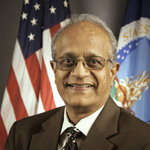
by Amanda Smith, Hoard's Dairyman Associate Editor
Recently, Sonny Ramaswamy was appointed to serve as director of the USDA's National Institute of Food and Agriculture (NIFA). In his new role, he oversees NIFA awards funds for a wide range of extramural research, education and extension projects that address the needs of farmers, ranchers and agricultural producers. At the Joint Annual Meeting, held in Phoenix, Ariz., we had an opportunity discuss the future of agriculture in the U.S.
In order for agricultural research to continue, it needs funding. Where do you see this funding coming from in the future?
Funding for agricultural research used to be a triangular partnership between the federal, state, and local governments and extension. Capital resources came from one of these sources with the beneficiary in the middle. Beginning in the 1980s, we began to see support from these sources decline. With new methods of applied research, the government doesn't have the wherewithal to continue supporting research at the level it used to.
Many agricultural sectors have already begun supporting research through their checkoff programs. From here on, funding for research will come from private, corporate or nongovernmental sources. Today, researchers live and die by grants. Corporations are being asked to step up and support research. It becomes muddled though when intellectual property considerations are brought into the equation.
How do we, as farmers, better promote agriculture in the U.S.?
In America, we must deal with the challenge that many people take agriculture for granted; the public doesn't realize that agriculture impacts them from the moment they begin their day. The average U.S. consumer spends 9 cents of every dollar on food. In Western Europe, China and Africa they spend 20 cents, 33 cents and 80 cents, respectively, of each dollar on food. But Americans have a greater level of consciousness regarding the food system than they did 5 or 10 years ago.
As director of NIFA, my role is to preach the gospel of food and agriculture. At meetings such as this we are excellent at talking to one another and using jargon. We can't continue to talk amongst ourselves; rather we need to invite, engage and talk to the public. The Smithsonian recently held an entomology event with a demonstration kitchen. While I cooked curried crickets, I had the chance to discuss entomology with the 300 audience members. For far too long, farmers have been a stoic lot, we need articulate spokespeople to begin preaching the gospel of what they do.
Next week we will share Ramaswamy's thoughts on if we are equipped to feed the world, who are our agricultural competitors and how we engage the next generation in agriculture.
Prior to this, Ramaswamy served as the dean of Oregon State University's College of Agricultural Sciences and director of the Oregon Agricultural Experiment Station.








